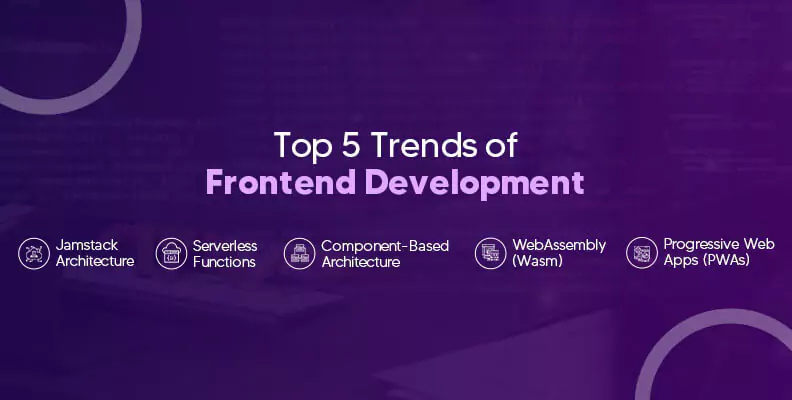Loading.....
Navigating the Shifting Sands: 5 Trends Reshaping Frontend Development

Frontend development is a dynamic within the world of web technologies and to thrive in this field, staying ahead of the curve is not merely advantageous; it's vital. If you've been in the industry like me for 2 years and have experienced a fair share of transitions and innovations, where what's cutting-edge today can become outdated tomorrow.
In this comprehensive blog post, I will share the latest trends that promise to shape the future of frontend development. By understanding and harnessing these trends, you can equip yourself with the tools and knowledge needed to thrive in this ever-shifting landscape.
Top 5 Trends of Frontend Development

- Jamstack Architecture
- Serverless Functions
- Component-Based Architecture
- Progressive Web Apps (PWAs)
- WebAssembly (Wasm)
The Jamstack architectural approach has witnessed a remarkable surge as this framework places a strong emphasis on the separation of the frontend and backend components of a website. Chief among these advantages is the noteworthy enhancement in loading times, which ensures that web pages load swiftly and efficiently. Furthermore, Jamstack architecture reinforces security measures, fortifying web applications against potential vulnerabilities.
The scalability of websites is also significantly improved, granting the flexibility to accommodate according to growing user demands. In sum, the Jamstack architecture represents a promising evolution in web development, offering a path towards optimized user experiences and robust digital landscapes.
Serverless architecture allows the capability to run code without managing servers, simplifying backend development and enabling frontend developers to build full-stack applications with ease.
The serverless paradigm fosters unparalleled efficiency and flexibility that promotes a more agile and user-centric approach to web and application development.
Component-based development using libraries like React and Vue.js is the norm. This approach not only facilitates the seamless integration of pre-built components but also encourages the creation of modular and reusable code snippets. As a result, it significantly enhances the efficiency and ease of maintaining web applications, making them more adaptable to evolving requirements and reducing development time and effort.
Components essentially serve as the fundamental units of modern web applications, offering a structured and organized way of constructing user interfaces and functionalities. These practices allow developers can harness the full potential of component-based development and unlock numerous benefits that elevate the quality and scalability of their web projects.
Progressive Web Apps (PWAs) have been steadily gaining momentum and are increasingly becoming a preferred choice for both developers and users. These provide a seamless and engaging experience that resembles the native mobile apps.
PWA’s standout feature is the ability to operate offline, ensuring uninterrupted functionality even when an internet connection is intermittent or unavailable. They additionally incorporate push notifications, enhancing user engagement and re-engagement. As a result, the development of PWAs has transitioned from being an emerging trend to an established standard in the contemporary web development landscape.
WebAssembly, often abbreviated as WASM, presents a revolutionary capability, enabling the execution of code crafted in languages such as C, C++, and Rust, directly within web browsers. By harnessing the power of WebAssembly, developers can create high-performance web applications that were once considered unattainable.
Moreover, it offers a game-changing opportunity for game developers, providing a seamless path to bring intricate and resource-intensive games to the web, offering users an immersive and engaging experience. Its versatility, coupled with its potential to improve web performance, renders it an indispensable tool which revolutionises the way we interact with web content.
How to Stay Updated with Latest Trends
To stay ahead in frontend development you need to enhance your online presence and reach a broader audience. Here are five proactive strategies to ensure your web development knowledge remains up-to-date and visible to search engines:
- Follow Influential Blogs and Websites
- Smashing Magazine
- CSS-Tricks
- A List Apart
- SitePoint
- MDN Web Docs
- Attend Webinars and Online Courses
- Engage in Online Communities
- Experiment and Build Projects
One of the easiest ways to stay updated in frontend development is by following influential blogs and websites which publish articles, tutorials, and news related to the latest technologies. Some of the popular websites you can consider:
When following these sources, make sure you subscribe to their newsletters or RSS feeds, so get updated regularly. Additionally, you can set up Google Alerts for specific keywords or phrases related to frontend development to get notified about the latest content in your niche.
Webinars and online courses are excellent resources for learning and some platforms I would be suggesting are Udemy, Coursera, edX, and Pluralsight. You can also explore webinars and workshops hosted by experienced individuals on platforms like LinkedIn Learning and YouTube.
Participating in online communities is a fantastic way to stay updated while networking with fellow developers. Websites like Stack Overflow, GitHub, Reddit (r/frontend, r/webdev), and various Discord and Slack channels are excellent places to engage in discussions, ask questions, and share knowledge. Active participation can help you stay informed about the latest developments, challenges, and solutions in the frontend community.
Leading developers and thought leaders often share their insights and discoveries on social media platforms such as Twitter and LinkedIn. By following experts like Addy Osmani, Dan Abramov, Sarah Drasner, and others, you can get real-time updates on their work, opinions, and the latest trends. Social media can be a goldmine of information for staying up-to-date in frontend development.
Learning by doing is one of the most effective ways to stay updated in frontend development. Experiment with new libraries, frameworks, or features you've read about. Building personal projects or contributing to open-source projects can provide hands-on experience and a deep understanding of the latest technologies. Consider creating a GitHub account and collaborating with other developers on projects of interest.
Conclusion
Frontend development is an exciting and ever-evolving field. Staying updated with current trends and preparing for the future is essential for success. As a frontend developer with 2 years of experience, you are well-positioned to embrace these changes and continue to grow in your career. Embrace these trends, experiment with new technologies, and be open to learning – that's the key to a thriving frontend development career.
 Back to blog
Back to blog












